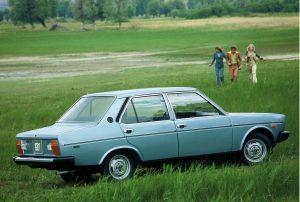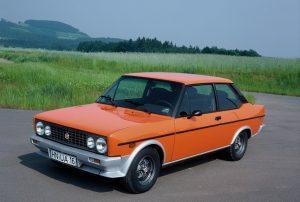In October 1974 Fiat presented the successor to 124. The Fiat 131 was faced with the task of continuing the success of its predecessor. Fiat succeeded in this mission by bringing a characteristically lined mid-sized car to the market, which also had a major rally career ahead of it and also performed excellently as a licensed model. The Fiat 131 became a worthy representative of Fiats' historic middle class.
The 131 was supplied with OHV four-cylinder engines with 1.297 or 1.585 cc from its introduction. A four-speed manual transmission was standard. A five-speed and three-speed automatic were only available with the 1,6-liter engine. The chassis consisted of the configuration with a rigid rear axle and McPherson suspension at the front. The drive took place via the old Fiat middle class recipe: via the rear wheels. There were three body styles: a two-door sedan, a four-door sedan and a station wagon, the Familiare. Fiat supplied the 131 in two trim levels, the entry-level 131 Mirafiori and the Mirafiori Special. The “S” was fitted with twin round headlamps, a different grille and chrome window surrounds, and was available with options not available on the entry-level version. Both trim levels were available with the aforementioned 1,3 and the 1,6 engine.
The second series and the Supermirafiori
The facelifted 1978 was presented in the spring of 131. From that moment on, most 131 variants sported large rectangular headlights, a black plastic grille, plastic bumpers and larger and rectangular rear lights. The station wagon was now called panorama. In June 1978 followed the “Racing”, a peppery two-door version called. The most important innovation was the arrival of the more powerful 1.301 cc and 1.585 cc engines with two overhead camshafts, which also had belt drive, Fiat terrified the competition. The 131 versions that got these engines were called Supermirafiori and were also loved. In addition, the old 1.297 cc OHV engine in various 131 models was replaced over time by the new SOHC engine with 1.301 cc.
Racing and diesels
On the outside, the biggest changes were larger square headlights (excluding the racing models and the later diesel versions with 2.0 and 2.5 self-ignitors), new bumpers, larger rear lights and a new interior. In that year there was also a 2-door sports version, the 'Racing' with a 2.0 liter engine with overhead camshafts, 115 HP and a five-speed gearbox with shorter transmissions. It had a top speed of 180 kilometers per hour. The diesel versions also got twin round headlights and had a noticeable bonnet bonnet to accommodate the taller engine. The station wagon was now called Panorama.
Third and last series
The 131 was updated in March 1981. The 2.0 liter engine from the Racing became available for the new 131 Supermirafiori 2000 TC. The Racing itself left the field. There was a slightly modified interior, a new 1367 cc engine and a modified 1,6-liter engine. There were also new gearboxes, modified wheel suspensions and a larger petrol tank with a capacity of 53 liters.
Abarth and the 131
In 1976 400 Fiat Abarth 131 Rally cars were made for homologation purposes. This was done in a collaboration by Fiat, Abarth and Bertone. Bertone used half-finished two-door bodies from the production line of the Mirafiori plant, fitted plastic front and rear fenders, a plastic bonnet and modified the body to fit independent suspension. The cars were completely painted and returned to the Fiat factory in Rivalta where the Abarth parts were assembled. The street version of the car had a 16-valve DOHC engine with twin Weber carburettors and produced 140 hp. In the WRC, the Fiat Abarth 131 Rally was extremely successful with dozens of victories. The highlights with the rally gun were the world titles of Markku Alén won the WRC in 1978 and Walter Röhrl in 1980.
Respectable number of built copies and license building
Just like the legendary predecessor 124 (in total concept including license construction one of the most built cars in history, please remember) the Fiat 131 was sold with a different name in various other markets. For example, the Seat 131, Tofaş Murat 131, and the Tofas models Doğan, Şahin and Kartal, among others, were also built, until almost 2010. Polski Fiat also built a variant: the 131p. In all its forms, the 131 rolled off the production line more than 3 million times, as a complete car or (in certain markets) as an assembly kit. The Italians built 1.500.000 copies of the 131, which as Fiat would eventually be succeeded by the Regata, and was finally retired as a station version in 1985 for the Italians.









I had an 132 1600tc. Nice row of car. Custard yellow. Richly peppered with rust brown. If you slammed the door shut you could hear the rust rustle down 😢. Always started. Was just before apk time
Great cars that those Fiat 131 and 132. Can drive with friends in both. Bikes ran beautifully and because of the rear-wheel drive they could also be driven in a sporty way, on the street, grass and dirt roads…!
Thanks to Fiat and friends😀